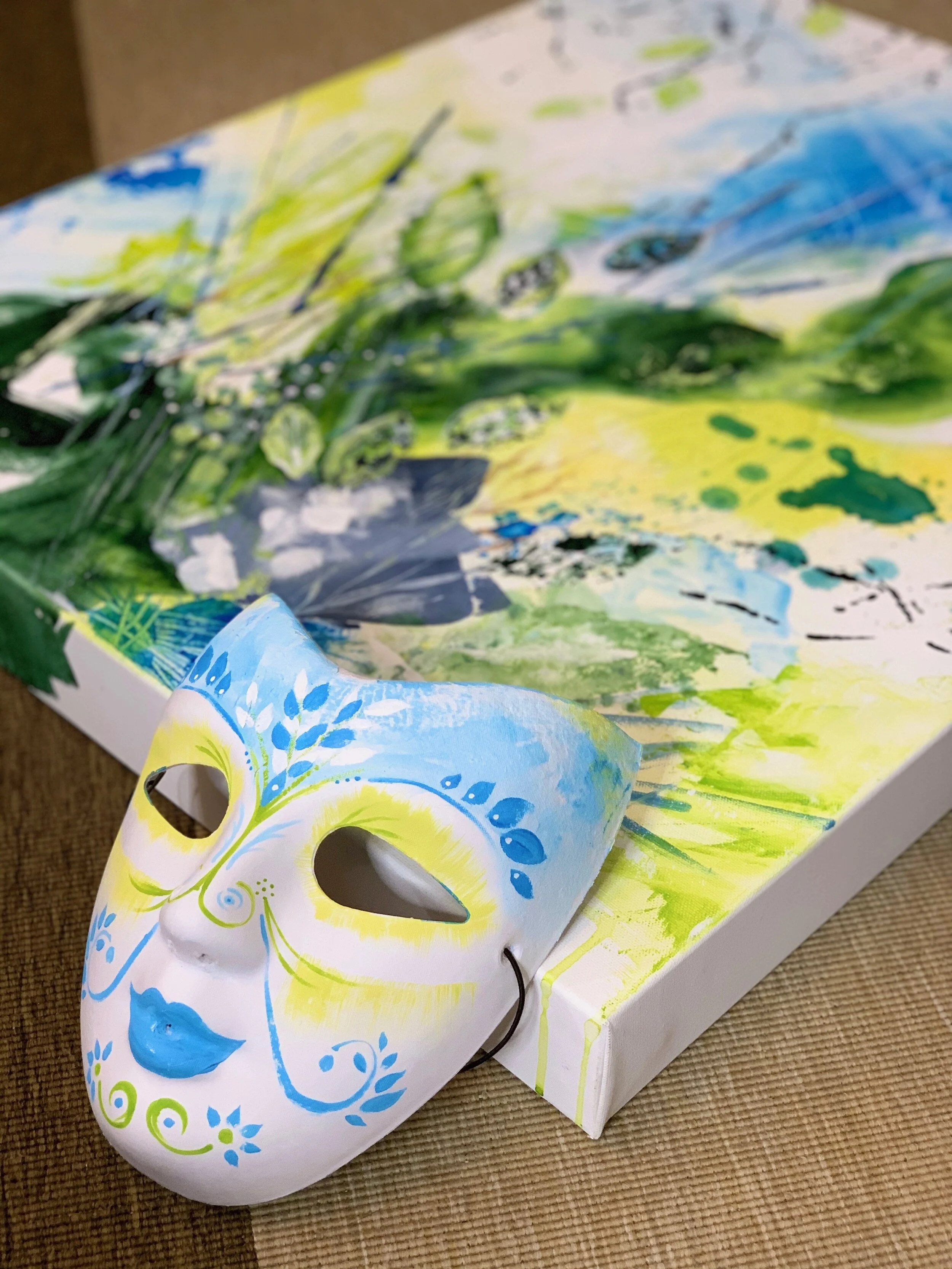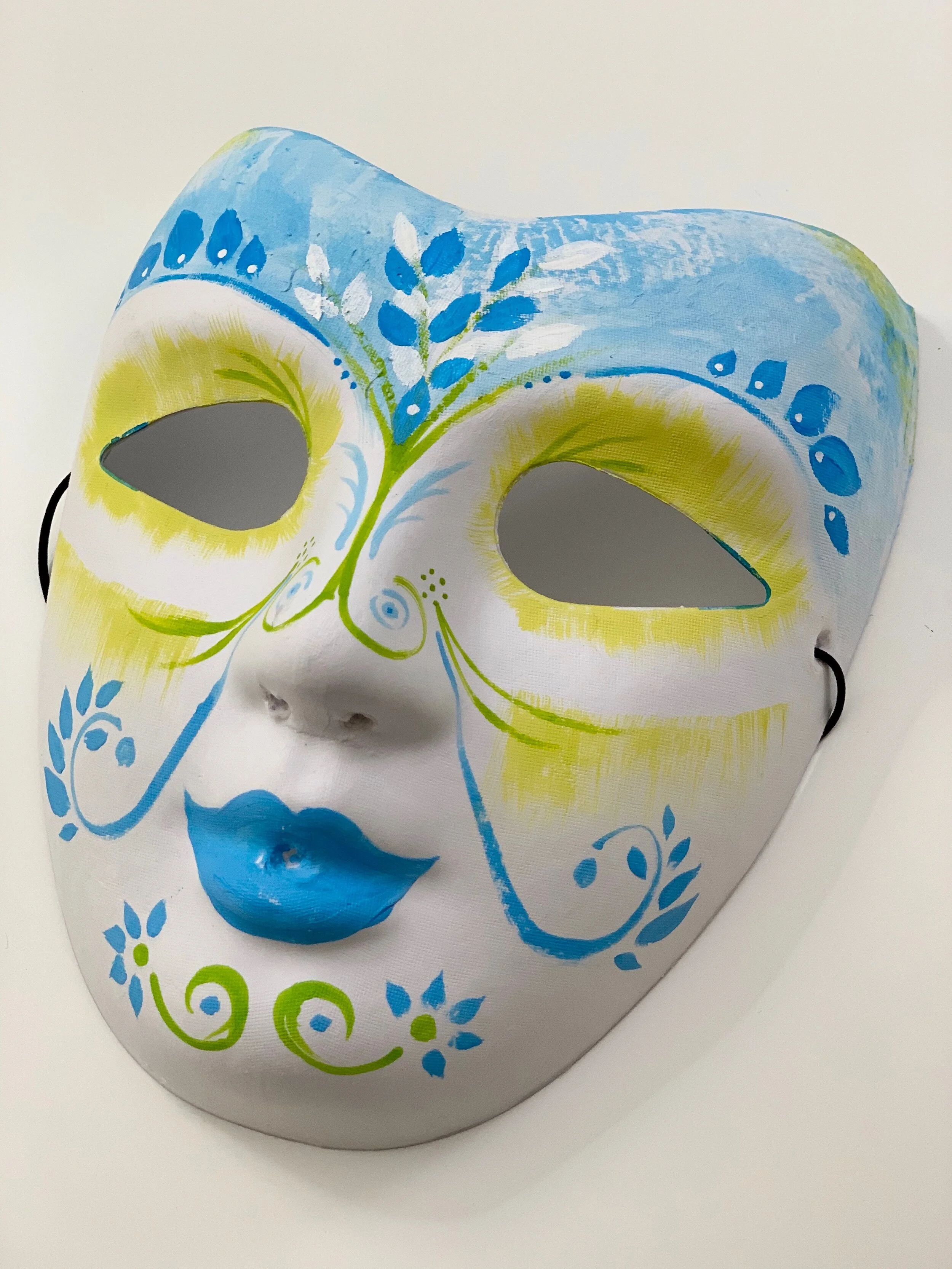The first painting in my new abstract series
July 1, 2020
The class was all about working with a mask. Interestingly, this exercise resulted in a huge realization for me: I learned to honor and embrace a side of myself that I have been trying to quiet as an abstract painter — the meticulous, graphic-loving, perfectionist side of me.
In our 4th expressive arts class we worked with and painted a white mask, not the surgical kind but the full-face masquerade kind. This mask work was an exercise in the development of our big project, and it brought out some interesting realizations for me.
I learned to make sense of two seemingly opposing sides of myself:
1) The painter who loves to paint energetically in an unplanned, abstract style, and
2) The painter who loves to work quietly, slowly and calmly in a highly detailed, delicately controlled graphic style.
I finally accepted and acknowledged that my graphic tendencies are an asset for me as a painter, not a hinderance or a trait that I need to suppress in order to be a successful abstract painter.
When setting up to work on our mask, I laid out the color palette I intend to use in my series, and I deliberately made this the only frame for my mask work. Rather than forcing myself to paint in a certain way or style, in class I just allowed myself to paint as I wished. Whatever I wanted. However I wanted. Whatever came out. With no preconceived idea or design in mind — just letting the brush dance across the mask.
Oddly, what came out was very different from the painting style I’m trying to work with in my new painting series. In fact it was the complete opposite style. My natural instinct with the mask was to paint delicate, decorative, graphic, symmetrical, controlled shapes and strokes. Nothing like the style I’m trying to achieve in my abstract painted series, which I envision as loose, unplanned, chaotic, yet somehow calming and renewing.
At first this felt very disjointed and confusing to me. I wondered if I’d failed the exercise. Why would I paint my mask this way when my series is meant to be abstract? How would this graphically-painted mask help in the development of a new abstract series? Why had I allowed myself to paint this way?! I must have done this exercise incorrectly. Surely it was a useless execution, and I should paint another mask in the “right” style. I should have made myself paint abstractly, loosely, asymmetrically!
At first glance the mask work had nothing to do with my new abstract series. Then it came to me one day as I was in the flow of painting the first piece in the new series. Yes, my natural inclination is to work this way — graphically, slowly, with intentional, controlled strokes. This is why I became a graphic designer! This is why I’ve loved the profession in which I’ve spent over 25 years! I like slow, thought-out work with delicate, intricate details. Working this way is very comforting to me. It’s soothing. It’s fun. It’s satisfying. Maybe that’s because it’s one of the only things I can truly control in life — how I express myself visually and how my expressions flow through my body.
I feel like my mask work brought to light a huge realization that has led to significant, mindful growth for me. I finally appreciate my meticulous, graphic tendencies. And, I’ve realized that I can use this quality to enhance my abstract work. It’s not a hinderance. It’s not opposite to abstract work because it’s detailed, slow and thought out. Painting abstractly doesn’t mean that I have to paint quickly. It doesn’t mean that I have to paint sloppily. It doesn’t mean I should unplug my mind so much that I give myself zero control over the final piece. In fact this perfectionist nature is a strength that I must honor, appreciate and embrace. I can use this natural tendency to improve my abstract work. I just need to use it thoughtfully and carefully.
So why was I negating this part of myself? Why did I not fully embrace it? Why have I been denying that side of me as an abstract painter? As I’ve been learning to paint abstractly I’ve been suppressing this side of me, forcing myself to push it away because it seemed like it was the complete opposite quality required to paint successful abstract work. But now I realize that if I use this tendency smartly, it can actually improve my work. It can help differentiate my paintings from the work that other abstract artists are doing. I just need to use it at the right time in my process.
After the mask work was complete, I began working on the first painting in my series. I forced myself to work extremely slowly, as this was one of the conclusions I’d made in my previous class assignment. There were days in the first week when all I did was paint for 5 minutes a day. One color at a time. Maybe two, but no more. In my first painting sessions I let creative chaos happen on my canvas without much planning. I would paint, then let the canvas sit for a day. I would look at it again with fresh eyes the next day and paint some more, adding to the composition and slowly bringing it together. Once the painting started to take shape I allowed myself to paint for longer sittings. I made smaller changes, working more thoughtfully — making small, detailed edits.
It was in these last painting sessions where I allowed my detail-loving nature came out. Once the piece was close to done, I looked at the work with my critical design-eye, noting where small, precise strokes would improve the piece, and I acted on that instinct. And in looking at my painting where it stands today, I believe this strategy worked. If I use this quality at the end to complete my pieces, my work can become even more unique and even more me.
So, I should use my critical eye and my evaluating, controlling mind at the right times — before and after a painting session but not during one. That way I allow both sides of myself to shine through. While the brush is in my hand I go with my free-flowing energy, following feeling and intuition, following the flow. Then I stop painting, and after enough time has passed, I give the work a highly detailed aesthetic examination. It’s a delicate balance I have to keep between incompleteness and perfection. This is where the magic exists — in the middle.
Painting #1 in my new series. It might not be done yet. I’m letting it rest now to re-evaluate later with fresh eyes.
Starting today I’m honoring my complete person and fully embracing all my natural tendencies. I’ll be working using both sides of myself: the crazy-making, energetic, loose painter and the meticulous, calm, perfectionist designer.
It’s fulfilling and relieving to know that I’m finally allowing real magic to start happening on my canvases. I’m letting go of my preconceived notions of what an abstract painter is and isn’t, and what she does and doesn’t do. I’m now opening my full self to my abstract expressions, letting go, and truly expressing my complete self.
Read my previous posts for this series:
Developing my initial concept: A whole new approach to abstract painting!
Initial style development: Can I hold my cherished moments sacred while laid bare?
Testing the style: A pilot project: painting studies for my new abstract series



